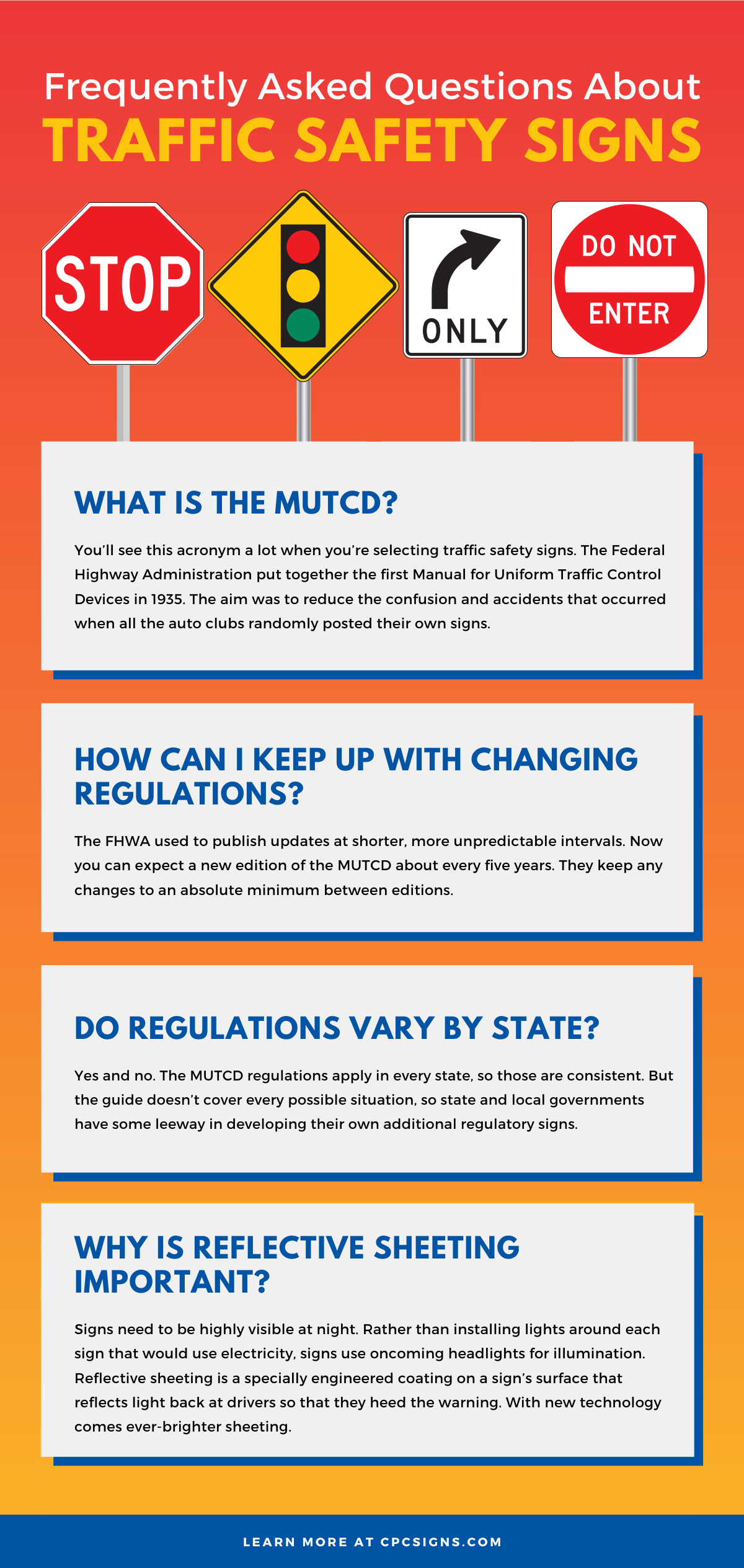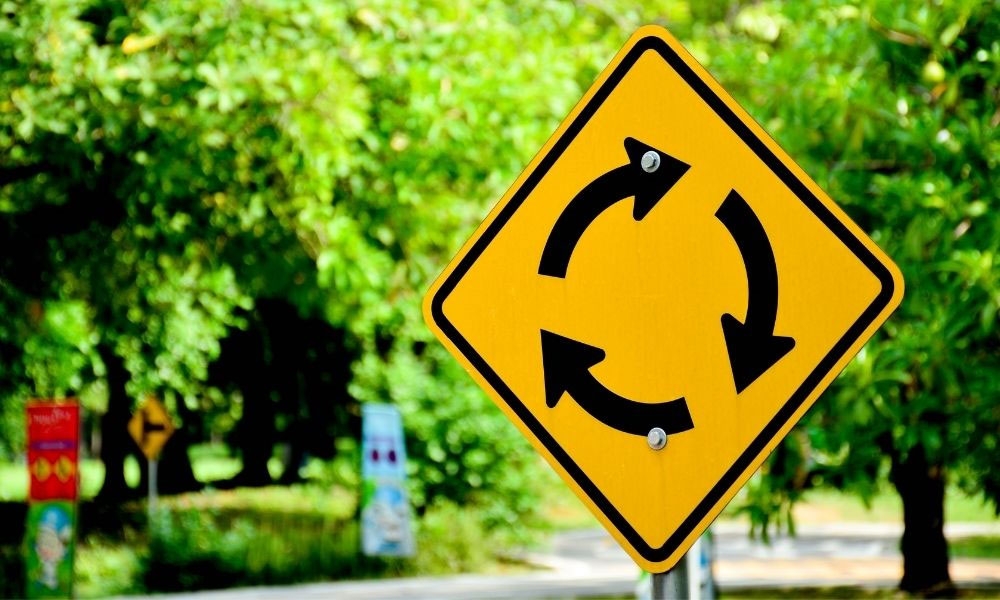Road signage comes with its own set of regulations and options. Find the answers to frequently asked questions about traffic safety signs here.
There’s a lot to know about buying road signs: regulations, materials, installation, maintenance, and more. If you’re not sure where to start, you’re not alone. Sifting through all the information can be a lot at once. The answers to these frequently asked questions about traffic safety signs can give you an overview of the process.
What Is the MUTCD?
You’ll see this acronym a lot when you’re selecting traffic safety signs. The Federal Highway Administration put together the first Manual on Uniform Traffic Control Devices in 1935. The aim was to reduce the confusion and accidents that occurred when all the auto clubs randomly posted their own signs. After extensive, cross-country research, the MUTCD set new standards for signs. Their guidelines included sign colors, shapes, and wording. The government has published eight more editions of the guide and made small changes in between. The MUTCD oversees signs, signals, and pavement markings in terms of:
- Design
- Application
- Placement
- Options
- Support provisions
How Can I Keep up With Changing Regulations?
The FHWA used to publish updates at shorter, more unpredictable intervals. Now you can expect a new edition of the MUTCD about every five years. They keep any changes to an absolute minimum between editions.
Do Regulations Vary by State?
Yes and no. The MUTCD regulations apply in every state, so those are consistent. But the guide doesn’t cover every possible situation, so state and local governments have some leeway in developing their own additional regulatory signs.
Why Is Reflective Sheeting Important?
Signs need to be highly visible at night. Rather than installing lights around each sign that would use electricity, signs use oncoming headlights for illumination. Reflective sheeting is a specially engineered coating on a sign’s surface that reflects light back at drivers so that they heed the warning. With new technology comes ever-brighter sheeting. Now, manufacturers can create signs with different kinds of sheeting:
- High-Intensity Prismatic Grade (lasts 10 years)
- VIP Diamond Grade (lasts 12 years)
- Diamond Grade Cubed (lasts 12 years)
Can Street Name Signs Be Any Color?
You can choose from five background colors for signs that designate a street’s name:
- Green
- Blue
- Brown
- White
- Black
You can also customize street name signs with several decorative borders and pole styles. Many cities have taken advantage of these options to beautify downtown districts and identify neighborhoods more clearly. CPC offers sign packages with sleek, vintage, or ornate themes.
Can You Combine Signs on One Post?
Yes, in these situations:
- You can combine two traffic signs on the same post if they supplement each other with a similar message, such as plaque signs.
- More than one regulatory sign (such as “stop,” “yield,” or “one way”) can be on the same pole as long as their meanings aren’t in conflict.
- You can combine street name signs with “stop” and “yield” signs.
Depending on which sign support you choose, you can also post your signs at different heights and on different sides. Just make sure the placement stays within regulations.
Can I Buy Just One Sign?
Yes, you can! Custom Products Corporation doesn’t require a minimum order.
How Do I Petition for a Stop Sign in My Neighborhood?
You can request a sign through your town or city council. To begin the process:
- Write a statement about why the stop sign is necessary. Include any observations you’ve made.
- Conduct research for further evidence. You can speak to other neighbors or ask your police department about accident records for the intersection.
- Get as many signatures as you can on a petition to support your request. Online petitions are just as credible as physical signatures.
- Attend a community meeting to present the petition.
- Follow up with a representative a few months later to learn if any progress has been made.
How Can I Prevent Road Signs From Being Damaged or Stolen?
- Graffiti Protection: At Custom Products Corporation, we offer protective overlay films that can minimize the effects of graffiti.
- Breakaway Technology: Signs along the highway use a breakaway system so that if a car strikes them, they detach from the ground and fly up and over the car’s roof.
- Heavy-Duty Fasteners: You can prevent damage with extra measures, such as expanding anchor bolts, nuts with shear-off heads, and fasteners that require specific tools to remove.
- Publicizing Penalties: Some municipalities put stickers on signs to warn about the consequences of stealing them. In most cases, the theft qualifies as a misdemeanor, resulting in a fine and up to a year in jail. But if a missing stop sign results in a fatal accident, the offender may face felony charges with a punishment of six years in state prison.
What If They Still Keep Getting Stolen?
Popular street names are subject to repeated thefts that are largely harmless. In these cases, the municipalities have to get creative with solutions to preserve the street’s signage. For instance:
- Penny Lane: Beatles fans couldn’t resist this sign as a souvenir in Liverpool, England. Authorities finally resorted to painting the name on building walls.
- Corona Street: This sign in Denver, Colorado, proved so tempting for thieves that the city decided to sell replicas of it.
- South Park Street: After Comedy Central’s cartoon found success, the council in Lawrence, Kansas, reinforced this sign with theft-proof bolts.
Did this help you find an answer? We’ve listed some of the most frequently asked questions about traffic safety signs, but every purchase is unique. Custom Products Corporation has been making streets safer since 1985 and can help you navigate guidelines and narrow down your choices. Contact us for more information.






